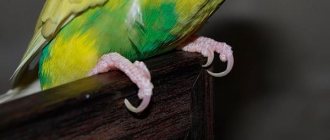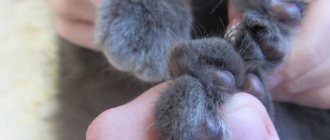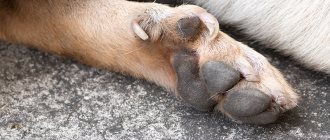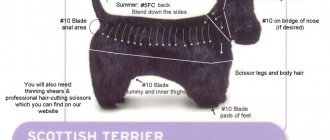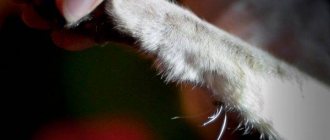Every member of the cat family has claws. They serve as protection from the dangers of the outside world. But pets do not need to regularly defend themselves, keeping enemies away. But sharp blades on the paws can cause a lot of problems for owners. Damaged furniture, wallpaper and other coverings look ugly. And when even special scratching posts do not improve the situation, owners decide to use scissors to fix the problem. It’s worth figuring out whether it’s possible to trim a cat’s claws and what to consider to make the process easier.
Why does a kitten need nails?
It’s clear why cats living outside need claws. And to escape from danger, and to feed. Why does a pet need them? He doesn't leave the apartment. And he has no idea what hunting is. Maybe you shouldn’t bother with the question of at what age can a kitten’s nails be trimmed? How about taking the baby to the veterinary clinic and getting rid of this sharp weapon?
So we get to the main idea. Claws are a cat's weapon. They are also compared to human fingers. It is the claws that help animals sense balance and play an important role in the pet’s spatial orientation. It has long been known that cats that are deprived of this important addition to their paws become “crippled.” Their musculoskeletal system is impaired.
Where is it better to get a haircut: at home or at the veterinarian?
If you are a frequent client of establishments where professionals take care of your cat: they do a haircut, monitor their health, entrust this work to them.
People with experience, a license and thousands of cut cat nails will cope with the task better than an inexperienced owner.
If visiting such establishments is not your thing, learn to do it yourself. Remember the basic rules, act boldly.
Rules for cutting your cat's claws yourself:
- Use special clippers or a nail clipper purchased at a veterinary pharmacy.
- Calm the animal. Do not force the procedure.
- Do not injure the sensitive pulp. You can seriously injure your pet and cause bleeding. Imagine cutting off the sensitive part of your nail. Your kitty will have the same feelings.
- Cut off no more than 2 mm. The goal is not to shorten the nail, but to remove the sharpness.
- Be sure to treat your claws after trimming with a solution of potassium permanganate or hydrogen peroxide.
- Praise your cat for his patience and good behavior. Give me something tasty. Over time, he will get used to it and will be happy to wait for you to finish the procedure.
- Trim only the front nails. The rear ones don't need this, they are shorter and not so sharp.
- If the animal's behavior is aggressive, contact a veterinary clinic. Specialists will help you cope with the task.
Remember: cutting your nails will only make them less sharp. The animal's bad habits will remain. It will simply cause less damage to the interior.
Don't despair if the first, third and tenth attempts are unsuccessful: after all, bears in the circus are taught incredible things.
Any animal can be trained. Be patient and the results will follow.
When can you start cutting your newborn's nails for the first time?
One of the first questions that a young mother has when caring for her baby is how long after birth can she cut her newborn’s nails?
?
As soon as the baby is born, the edges of his nail plates do not separate from the skin, as they are quite soft. This is why you should not cut a newborn’s nails in the first two weeks - to avoid skin damage and, as a result, a possible inflammatory process. To prevent the child from scratching himself during this period, it is recommended to wear special mittens.
A month after birth, you can safely start cutting your baby’s nails.
Removal
At what age can a kitten's nails be trimmed? How should an adult cat cut them? Do you need to go to the clinic every time? At home, on your own? No, your hand won't rise. We'll have to carry it. And this will take time. Remove these claws once and for all. Moreover, why does the cat need them? Should I sit at home with my claws? Only the sofa spoils the wallpaper, he ignores the scratching post, he’s a bad creature. This is a bunch of questions swirling around in the owners’ heads.
The owner loves his animal and wants to do the best for everyone. It would be nice to rid the kitten of its claws, as it doesn’t seem to need them at all. And yourself - from problems with damage from these very claws. Just before taking your pet for surgery to remove them, you need to think several times. Is it worth it?
As mentioned above, in animals without claws the functioning of the musculoskeletal system is impaired. And that is not all. A cat, deprived of its main support and tool for protection, experiences extreme stress. Once outside, such an animal will die immediately. He has no chance of salvation.
Here the emphasis has been long and persistently placed on the musculoskeletal system. Someone will be surprised what claws have to do with it. The thing is that during the declawing operation, the phalanges of the cat’s fingers are cut off. Imagine that a person has been partially deprived of his toes. How will he walk after this? And now it becomes clear what it’s like for the cat.
Why does a cat need claws?
When the cat was wild, they were needed so as not to remain hungry and not become the prey of a stronger animal. Then why do cats have claws now? There is no need to hunt - the food is always in the bowl, and those living at home have no purring enemies.
Progressive owners decide to take radical measures and declaw the cat. This is strictly forbidden. In almost all European countries, this operation, called onychectomy, is prohibited because it causes irreparable harm to health.
An improperly performed surgical operation can lead to:
- to gait disturbance;
- constant pain in the paws;
- development of infectious diseases.
The operation involves removing the claw and cutting off the phalanx of the finger. The healing process is very difficult and painful. Getting up on her paws is painful and she will limp or not be able to walk at all. The cat will lick the sore spots and will have to wear a special collar. An additional health risk is general anesthesia.
Typically, animals after onychectomy become irritable and capable of showing aggression. Unable to defend themselves otherwise, they may bite. The cat will not be able to jump even to the minimum height.
Tendonectomy is no less traumatic - cutting the flexor tendon, which ensures the release of the claws. A part of it is cut off, and the cat will always keep its claws retracted and will not be able to scratch or cling to anything.
The discomfort and pain that the pet experiences are a small part of the negative consequences. The joint cannot move normally, and the tendon takes a long time to heal. The cat suffers physically and is harmed to its mental health. There is a danger of infections and other complications.
Subsequently, you will still have to trim the overgrown claws, since the cat will not be able to do this on its own. So isn’t it better to do this regularly, without causing unnecessary pain to your beloved pet?
What to do if your cat resists
Cutting a small kitten's nails is not recommended.
They are not strong enough to cause harm. The main danger is the procedure for the animal itself. Thin claws do not allow you to see the beginning of the sensitive area. It is easy to injure a kitten and cause an infection.
Important! Veterinarians advise starting to trim nails at 2.5 months. You can wait until 3 or 4. This makes it easier to accustom the animal to the procedure. Once you start trimming the claws of an adult animal, you will encounter resistance. The cat will bite, kick, and become hysterical. A kitten accustomed to the procedure will behave calmly even as it matures.
Another advantage of starting the procedure at an early age: you will learn how to easily squeeze out claws. Cats hide them: they pull them in and release them as needed.
If you decide to undergo the procedure at home, be patient and have the necessary tools.
Consider:
- Claw clipper. Your nail clippers will not work, nor will your garden pruners. The instrument will have to be purchased at a veterinary pharmacy.
- Potassium permanganate solution or hydrogen peroxide. We don’t want to introduce an infection to our beloved kitty.
- Cotton wool.
- Nail file.
| № | Actions | Explanations |
| 1 | Prepare all tools in advance, sterilize them: wipe with alcohol or dip in boiling water | The cat will not give you a chance to go get the missing supplies. He is unlikely to be delighted with your idea |
| 2 | Calm the animal | Pet the cat. It is better if he is full and satisfied |
| 3 | Hold the tool perpendicular to the nail | A different position will cause separation of the keratinized part |
| 4 | We press on the paw and see how the claw comes out under pressure. Cut no more than 2mm from the tip | This is enough for the animal to lose the ability to tear wallpaper, chair covers and curtains |
| 5 | We cut each paw separately, file it, treat it with peroxide or wipe it with a solution | No need to file |
This is what the ideal procedure looks like: calmed, squeezed, trimmed, filed and processed. There is little chance that the cat will look indifferently at the TV during the manipulation.
If the animal actively resists, the procedure should be interrupted. Do not put your cat into a stressful situation.
Important! If you manage to cope, remember: you should trim the claws only from the front paws. Don’t be alarmed if, when counting, you find only 18 nails: there are exactly that many of them in cats. 4 on each hind paw, and 5 on the front paws.
If your cat won’t let you cut her nails, you can try to accustom her to this procedure gradually, the main thing is to be patient.
Try a few simple tricks:
- If your cat doesn’t have enough patience for a long time, start small. To begin with: cut two claws and release the pet, not forgetting to praise. Then cut off more, and increase the number of toes until you have processed all the paws.
- Wait until the cat has no desire to resist when she has eaten and becomes sleepy.
- Try trimming nails while your cat is sleeping.
- If your cat becomes stressed due to the procedure, you can try giving him sedatives using natural herbs, for example, “Cat Bayun”.
- If you catch a kitten in a playful mood, you should postpone claw trimming until the kitten becomes less agitated.
We hope that our article will help you develop an effective strategy for trimming your pet's nails. If your cat won’t let you get close to his manicure with scissors or has an aggressive character, then we recommend reading our article about silicone anti-scratch pads (harmless to the pet’s body and a solution for responsible owners). Share with us and our readers in the comments: what tricks do you practice when trimming your cats’ claws?
Of course, the most important thing you can give your cat is attention, love and care. However, in addition to this, caring for your pet also falls on your shoulders. Therefore, it is important for all furry owners to know how to trim a kitten’s claws. This will help avoid incorrect actions and make the procedure much easier, faster and safer for the animal.
Many people today wonder whether it is necessary to trim a cat’s claws? I cannot give you a unanimous answer to this question. Of course, if your pets behave quite neatly and do not damage the furniture, then the process of trimming their claws is not so necessary. In addition, there are special devices for purrs called “scratching posts.” They allow you to get rid of old claws much faster.
However, I have to admit to you that not all furry people actually recognize such products. They can climb on scratching posts, lie near them, or even play with them. However, as soon as you turn away, the animal will go to sharpen its claws towards your favorite sofa.
In nature, everything is much simpler and more thoughtful. Outdoor cats climb trees, thereby getting rid of old claws. At home, your favorite interior items can be used for the same purpose. In addition, in the process of falling off, the claws often begin to separate or bend, growing under the skin. In this case, the animal may feel severe pain.
Why is nail trimming the ideal solution? Compared to some surgical operations (onychectomy), which are offered by many modern veterinarians, trimming a cat’s nails with scissors at home does not harm the physical and mental health of the furry cat.
Do you want to figure out how to trim a cat's claws at home? First of all, please note that this procedure must be treated as carefully as possible. Be sure to make sure there is bright lighting in the room.
We suggest you read: How to transport a puppy on a train, car, plane?
It is also important to prepare all the necessary tools for trimming claws. They can be quite different (in the form of scissors, forceps, guillotine nail clipper). Each kitten is unique - some may have thin, brittle claws, while others may have large and sharp ones. Therefore, I recommend that you stock up on all the options and, during the procedure, experimentally find out which type of scissors is convenient for you and your pet.
Cat nail clipper
To trim your cat's claws, you will need:
- Nail clipper (sold at any veterinary store). It is this tool (and not ordinary nail scissors) that veterinarians recommend. The design of scissors for trimming cat claws allows you to quickly and conveniently give even the smallest pet a manicure.
- Trimmer for cutting hair around claws. Sometimes, in order to trim cats' nails as quickly and safely as possible, you should cut off a little hair on the paw.
- Cotton wool.
- Antiseptics for disinfection and stopping bleeding (in case of a wound). The best option is hydrogen peroxide.
- File that prevents delamination.
By the way, many veterinary stores sell a so-called “manicure set” for cats. It contains all the necessary tools and is specially designed for trimming cats' nails.
Nail trimming and breed
At what age can you cut the nails of a Scottish, Siamese or Persian kitten? In fact, nothing depends on the breed here. It all depends on the age of the animal. Claws are formed in felines by the age of 4-6 months. It is during this period of time that owners begin to prune them.
Do I need to take my pet to the veterinary clinic for this? If the owner is very afraid to perform the procedure on his own, then it is possible. But there is nothing complicated about this manipulation. Below we will tell you in detail how to trim your pet's claws.
How to trim claws correctly?
It is important to learn how to trim your furry pet's nails correctly. Inept actions can lead to serious injury and severe stress for the animal. If there are significant doubts about the correctness of your actions or fear of manipulation, it is recommended to entrust the first haircut to a professional, so that, after observing the process, you can subsequently repeat it at home without any fears.
Haircut procedure
How to trim your little friend's nails? This is the most important question owners ask. And no wonder, a person is afraid of hurting his animal. Particularly fearful people go to a veterinary clinic and entrust the procedure to specialists. And for those who decide to cut their nails on their own, detailed instructions are provided on how to do this.
At what age can a British kitten's nails be trimmed? As mentioned above, breed does not matter. Only sphinxes begin to cut their claws earlier than others because of their skin characteristics.
But let's move on to the most basic thing - the haircut procedure. What you need to know about it:
- The necessary tool is special nail clippers for cats. Sold in pet stores. Or you can get by with simple nail scissors, nippers or tweezers. Nail scissors have been tested by the personal experience of many owners.
- Before starting the procedure, the instrument must be disinfected. Wipe with alcohol, for example.
- Pick up the kitten. Sit with him on a chair or in an armchair near the window. To see the blood vessel in the nail without damaging it, you need good lighting.
- We sit the kitten facing us.
- Nail trimming begins with the front paws. The paw is taken between the fingers and lightly pressed on it so that the animal releases its claws. The claw is lifted with a tool and only the light base is cut off without affecting the blood vessel.
- After the claws on the front paws are trimmed, we proceed to the hind paws.
- At the end of the procedure, you can praise the kitten and give something tasty.
As you can see, the procedure for trimming nails is not as complicated and scary as it seems at first. By the way, let us remind you at what age you can cut a kitten’s claws. From 4-6 months.
How to properly trim a cat's claws: methods at home
If your cat won’t let you cut her nails, you can try to accustom her to this procedure gradually, the main thing is to be patient.
Try a few simple tricks:
- If your cat doesn’t have enough patience for a long time, start small. To begin with: cut two claws and release the pet, not forgetting to praise. Then cut off more, and increase the number of toes until you have processed all the paws.
- Wait until the cat has no desire to resist when she has eaten and becomes sleepy.
- Try trimming nails while your cat is sleeping.
- If your cat becomes stressed due to the procedure, you can try giving him sedatives using natural herbs, for example, “Cat Bayun”.
- If you catch a kitten in a playful mood, you should postpone claw trimming until the kitten becomes less agitated.
We hope that our article will help you develop an effective strategy for trimming your pet's nails. If your cat won’t let you get close to his manicure with scissors or has an aggressive character, then we recommend reading our article about silicone anti-scratch pads (harmless to the pet’s body and a solution for responsible owners). Share with us and our readers in the comments: what tricks do you practice when trimming your cats’ claws?
Benefits of claw trimming
The question of whether a cat’s claws need to be trimmed is a top priority for owners, and many decide positively. Compared to removal, this method is still much more humane, and the cost of declawing a cat is quite high. Firstly, pets cannot grind their claws down to the desired size on their own; they grow too long and can peel off, become ingrown and injure their paw pads. In addition, cats have a so-called fifth claw located on the back of their front paws. This nail always grows freely, without participating in the cat’s scratching, and therefore she does not have the opportunity to sharpen it.
If you do not take care of the animal's claws and do not trim them if necessary, the fifth claw can begin to grow in and cut quite painfully into the pads of the paws.
There is no need to cut it too often; it is enough to do it during the main procedure.
Secondly, we cannot ignore the everyday side of the issue. Almost all owners of domestic cats have had to live in an apartment with peeled wallpaper and sofa upholstery, scratched furniture and flooring.
Thirdly, the question of whether it is possible to cut the nails of cats is always answered in the affirmative by owners of purebred animals - such a haircut is a necessary procedure before exhibitions. Pedigree kittens often have their claws trimmed in the first week after birth.
Finally, this procedure is simply necessary if there are children in the house - whether cats can have their claws trimmed varies from owner to owner, but the child must be completely protected from possible injuries. Or, instead of cutting the claws, you can try putting special caps on the cat.
Why trim your nails?
This question interests all cat owners. Domestic cats need to have their claws cut because, unlike street animals, they do not walk on asphalt, stones, or climb trees, where they can take care of their claws themselves. Long claws interfere with the movement of pets and also cause them discomfort. If you do not trim your animal's claws, there is a chance that it will begin to sharpen them on upholstered furniture. But you don’t want this outcome, do you? Therefore, to make life easier for the animal and you, carry out this procedure at an early age.
But if you sometimes let your cat out on the street, then do not cut the claws, because the animal needs them for protection. Even partially outdoor cats can take care of their claws themselves, actively running and climbing trees.
If your pet occasionally goes outside, you are putting him at great risk. As a result, the animal will become easy prey for dogs. And with the help of sharp claws, the cat will protect itself from dogs and other cats.
At what age can you start?
If the breeder has never trimmed the puppy’s nails, then try to accustom the baby to cutting his nails literally from the first days of his stay in your home.
If you have acquired a 2-month-old baby, then it is quite possible to accustom him to this procedure . After all, the sooner you start, the easier it will be for you in the future, since the pet will not be afraid and nervous.
Expert opinion
Kozhevin Semyon Kirillovich
Expert dog handler.
“Experienced breeders try to start trimming puppies’ nails as early as possible, from about 1.5 to 2 weeks of age. This is necessary so that the baby does not scratch the mother’s mammary glands and she does not refuse to feed. Sometimes, such a haircut is a matter of survival of the whole litter. And since puppies’ nails grow quickly, they are trimmed at least once every 2 weeks. For an adult dachshund, one haircut per month will be enough.”
How to trim a kitten's claws - nail clippers and improvised tools?
Let's say you have an urgent need to give your pet a manicure. How to trim nails yourself without harming your pet? If you have a nail clipper, the task becomes easier. If the kitten is about to have its nails trimmed for the first time, and you don’t have the tools, you can use improvised media while observing safety precautions.
Important! Don't set yourself the task of trimming all of your kitten's nails at once. If you were able to cut one claw in one approach, this is already a success.
Regular scissors
The first thing that comes to the mind of an inexperienced owner is to trim the pet’s claws with ordinary scissors, but is this possible? Hypothetically, you can...if:
- The cat will not twitch.
- You have a steady hand.
- The cat has thin claws.
- You only need to trim the ends.
What could go wrong? The structure of a cat's claws is significantly different from that of a human. When using regular scissors to trim nails, there is a very high probability of:
- Crushing a claw is very painful.
- Injuring your finger if the cat pulls its paw is even more painful.
Have you injured your pet unknowingly? In such a situation, it is extremely important to quickly stop the bleeding and ensure that the wound does not become infected. The injured claw will grow back, after which it needs to be trimmed. If the wound looks serious or your finger is injured, it is best to consult a doctor. If you don’t have nail clippers at hand, and your claws urgently need to be shortened, it’s wiser to use a nail file or nail scissors.
Nail scissors
A small kitten (1-3 months old) can have its nails trimmed with nail scissors. The only nuance is the model of the scissors. Nail scissors can be distinguished by their tips:
- Curved - for cuticles.
- Direct.
- Rounded – safe for cutting off hangnails and corners of nails.
Nail scissors with rounded tips are suitable if the nails need to be blunted rather than trimmed. Simply put, if you only need to cut off the ends so that the baby does not cling to the bedding and injure himself, you can hold off on buying nail clippers.
Can nail clippers be used to trim nails?
Nail clippers (for humans) are one of the most common tools used by inexperienced owners to injure cats. To painlessly shorten your pet's claw, you need to cut it at an angle. The blades of the tweezers close straight, but in order to set them at the desired angle, the cat's paw will have to be bent at an unnatural angle.
Again, if your pet has an exceptionally calm temperament and lies motionless in any position during the procedure, tweezers are suitable. If the pet jerks its paw when the claw is caught between the blades, it will be injured. By the way, if you use tweezers, even veterinary ones, the pressure on the handles should be firm and sharp. By cutting the claw slowly and smoothly, you risk crushing it.
How to use a guillotine correctly
Have you bought nail clippers and don’t know how to use them? The good news is that the guillotine is easy to use and the procedure is safe. The second news is that you probably won’t be able to trim all the claws the first time.
First, check your pet's reaction by touching the guillotine to the claw. Click the claw clipper and watch the reaction again. If the cat does not pull back its paw, you can try cutting it. Be sure to hold your pet's paw with your free hand. Cut off only the tip (sharper) of the claw. Your movements should be confident and firm. The guillotine cuts the claw at an angle, so the pet should not experience any discomfort.
Trimming cat claws at home
Do I need to trim my cat's claws?
Should you trim your cat's claws or not? On the Internet, supporters and opponents of the procedure break their spears, but everyone decides for themselves and I think a lot depends not even on how sorry you are for your great-grandmother’s antique chest of drawers or wallpaper. And it depends on how close a friendly relationship you have established with your animal and how many clawed animals live in the same apartment.
Our first acquaintance with scissors for trimming claws took place about a month after the Chupacabra arrived at its new home. The furniture was somehow indifferent; the cat liked wires more. But more than wires, he loved to settle down in my hair on the pillow and begin to “claw” his mistress’s head with special tenderness. When it became clear that scalping could not be avoided, we went to a veterinary pharmacy and bought special nail clippers - a guillotine trimmer.
Mmyaaaaaaaaaaaaaaaaaaaaaaaaaaaaaaaaaaaaaaaaaaaaaaaaaaaaaaaaaaaaaaaaaaaaaaaaaaaaaaaaaaaaaaaaaaaaking on on the owner's lap, belly up. This loud, mournful “Mryaayuu” accompanied the entire grooming procedure, while the cat was coaxed and kissed on each paw, so that no one else was hurt, although one of the paws was catastrophically close to the owner’s neck.
With age, the Chupacabra became more relaxed about the procedure for trimming its claws, and I began to trim its claws correctly - after all, you can’t just cut off the tips of a cat’s claws, you need to do it at the right angle and without going beyond the norm.
At the same time, we have a scratching post in the house. But a cat doesn’t always only need it for nail hygiene, and it’s the haircut that saves us from unnecessary injuries - after all, we also have a second cat with special needs.
Although, even with their claws trimmed, my cats pulled up two duvet covers into rags - that’s just their hobby!
A cat needs claws when it lives in the wild. A domestic cat climbs trees less and is generally less mobile, so its claws do not wear down and often grow longer than necessary. And then the cat turns into a Cheburashka - constantly clinging to everything with too long claws. Which can lead to injury to the animal, which no one would want.
It is important to understand that trimming a cat’s claws does not hurt. If you do it correctly and carefully, without touching the nerve endings
And she may hiss and be indignant out of fear of a new, unfamiliar object in your hands.
The need for this procedure is determined by the owner. All domestic cats can have their nails trimmed; it will not harm them in any way. Unless it's a cat that lives outside, it needs its claws for protection. There is an opinion that a cat that is accustomed to clinging with its claws when jumping may be injured if its claws are trimmed. This is possible in very rare cases, if the cat is used to climbing on curtains, for example. But this does not apply to animals that were taught to trim their nails as children.
It is necessary to trim the nails of older animals if they have a problem with ingrown claws, they do not file down their claws properly and they grow too long and can pierce the pads of their paws. This causes pain and discomfort for the cat and can also lead to suppuration.
What tools can you use to trim a cat's claws?
The choice of tool for trimming a cat’s claws depends on the capabilities and skillful hands of its owner. Some people use regular nail scissors or nail clippers; we bought special scissors with a hole for claws - a guillotine trimmer. There is essentially no difference, it’s just that it’s probably more convenient to cut with special scissors.
There is also an electric cat claw trimmer, somewhat reminiscent of a mechanism for a hardware manicure. I don’t know how your cat will react to this - mine don’t like buzzing objects and, I’m afraid, it would be completely impossible to hold it in your hands while trimming its claws with such a device.
Some websites now sell special restraining overalls for particularly violent ones. If your cat absolutely refuses to part with the scratches peacefully, perhaps such a device can make your life easier
When should a kitten's nails be trimmed?
The first time the claws are trimmed is when the kitten is one month old. It is advisable that at this time he is tired and sleepy.
During the procedure, you should not play with it: it will only interfere. You should not frighten the animal, use force, or beat it. This will cause psychological trauma to the pet. In the future, the cat will be afraid of trimming.
For kittens, use guillotine cutters. The procedure must be carried out with caution, cutting off only the very tip.
What is required for a haircut at home?
A set of necessary tools:
- Hemostatic agent. This could be flour, baby powder, or hydrogen peroxide in case you hit a live part of the nail and your dog bleeds.
- A nail file is needed to remove irregularities, sharp corners and nicks after cutting.
- It is better to purchase a special nail clipper at a pet store or grooming salon.
- Cotton pads.
- Pet treat. Be sure to reward him if he behaved well during the procedure.
IMPORTANT!
Under no circumstances cut your dog’s nails with regular scissors, otherwise you will not only injure him, but also scare him.
Then cutting will become a real problem.
Simple tips on how to trim a kitten's claws
This procedure is not easy, so the kitten should be accustomed to it as early as possible.
It is necessary to trim your pet's nails when he is in a calm state and in a good mood.
To trim a kitten's claws, you need to:
- Before trimming the claws, you need to wash your hands and treat the device with which you will trim the kitten’s claws with an antiseptic.
- Then, take the kitten in your arms, pet it and cuddle it. It is necessary for the pet to calm down and not be nervous.
- Take your baby's paw in your hand. You should hold it gently, but very firmly.
- Gently press the pad and the claw will open.
- Take a closer look at the claw; it should be cut off in the place where the claw is transparent. Where there is pink tissue, you should never cut it, as this will cause serious injury to the kitten.
- Trim the free edge of the nail; if the cut is not even, file it.
- Repeat all steps, trimming the rest of your pet's claws.
- After you have trimmed all the nails, praise your pet and give him a treat.
If you accidentally hit a blood vessel and your kitten starts bleeding, don't panic. Treat the wound with hydrogen peroxide, and in the future, be careful.
What to do when the animal is not given?
Pets have different temperaments. There are aggressive and nervous cats. They are unlikely to allow their nails to be trimmed in peace. Most likely, the animal will scratch, bite, and break out.
If the cat does not give in, you cannot show force: this can injure its paws. It is advisable to perform the procedure by two people: one holds, the other trims the claws. You can also swaddle your pet or wrap it in a blanket.
If he is very nervous, it is better to refuse the event and do it when the animal is more pliable and balanced.
At what age is it better to cut a cat’s claws: advice from veterinarians
For such an important procedure, you need to use the right moment - when the cat is sleepy or simply calm. If your pet clearly expresses its dissatisfaction - it bites, breaks out, scratches, then you need to calm it down by stroking it. Be sure to praise the cat, even the naughty one.
There are harmful cats and cats that do not get used to the process of cutting their claws, no matter how hard you try. In this case, you can wrap the pest in a blanket and pull out each paw one by one.
The main thing is for the pet to understand that there is nothing terrible in the procedure, and at the end he can receive some pleasant bonus in the form of a treat. If you start cutting nails without reassuring your pet, you risk seriously damaging his trust in you.
Here's what not to do:
- Scolding and screaming will cause even more fear in your pet, and it will be extremely difficult to trim claws in the future.
- Trying to catch a cat around the house while playing - the cat will respond to this with aggression, misunderstanding and indignation.
- “Break” a cat by force – you shouldn’t hurt it by trying to get your way.
READ What are the consequences after castration of a cat and what to do
How often should the procedure be performed?
The frequency of nail trimming depends on the conditions in which the dog lives. If your pet lives in the city and walks along the asphalt sidewalk every day, then you will trim its nails less often.
If you live outside the city, you will have to do this more often..
After all, when walking on a soft earthen surface, the claws do not wear down and can grow to serious sizes, and this is fraught with consequences.
Generally speaking, an adult dachshund's nails should be trimmed once every 3-4 weeks..
How can you tell when it's time for a haircut? By the characteristic sound of claws on the floor. As soon as you hear a clattering noise, you know it’s time to trim your nails.
Do I need to trim my cat's claws?
The number of procedures for cutting claws varies, and this is not surprising - the characteristics of each cat’s body are individual. For one cat, it is enough to trim its claws once a month; for another, the treatment will need to be repeated three or even four times. Be guided as the claws grow. If the cat is accustomed to a scratching post, then she will naturally partially grind off her claws, which will prolong the effect of trimming. And if you haven’t managed to develop such a useful habit yet, you can read our effective tips for teaching a scratching post.
As a rule, the more often you trim your nails, the better, even if you trim just a little at a time. By trimming its claws too infrequently and with slow growth, the cat will have time to wean itself off the necessary procedure, and you will have to retrain it.
Claw care is especially important for cats attending exhibitions. For them, cutting nails is not only a hygienic procedure, but also a cosmetic one, since all exhibition animals must not only be healthy, but also look impeccable.
When is the best time to cut a baby's nails?
For a newborn, such a process is new and unusual. In order to leave only good impressions about this in the subconscious, it is important to cut nails only when the child is in a calm state
.
The best time to do this:
- after satisfying the child’s physiological needs: feeding and changing diapers, when the baby is not suffering from colic, nothing bothers him, he is in a good mood, full and happy with what is happening around him. In the process of treating nails, you should smile at the baby, talk to him, sing affectionate songs, create an atmosphere of kindness, calmness and comfort;
- during bathing, the nail plates become softer and more amenable to treatment, so after taking a bath it’s time to do this procedure;
- if your child is quite active when awake, then you can carry out this procedure while sleeping, but you should be doubly careful not to injure the child. After all, if this happens, then this factor may negatively affect the baby’s psyche and there may be problems with falling asleep.




